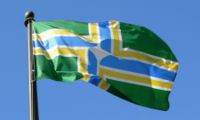
Flag of Portland, Oregon
Encyclopedia


Flag
A flag is a piece of fabric with a distinctive design that is usually rectangular and used as a symbol, as a signaling device, or decoration. The term flag is also used to refer to the graphic design employed by a flag, or to its depiction in another medium.The first flags were used to assist...
of Portland, Oregon
Portland, Oregon
Portland is a city located in the Pacific Northwest, near the confluence of the Willamette and Columbia rivers in the U.S. state of Oregon. As of the 2010 Census, it had a population of 583,776, making it the 29th most populous city in the United States...
, consists of a green field on which is placed a white four-pointed directional star from which radiate blue stripes, each bordered by L-shaped yellow elements. Narrow white fimbriation
Fimbriation
In heraldry and vexillology, fimbriation refers to small stripes of colour placed around common charges or ordinaries, usually in order for them to stand out from the background, but perhaps just because the designer felt it looked better, or for a more technical reason to avoid what would...
s separate the blue and yellow elements from each other and from the green background. The standard size is 5 ft in length by 3 ft in height.
City ordinance 176874, adopted September 4, 2002, designates the design and its symbolism. Green stands for "the forests and our green City"; blue for "our rivers" (Portland is at the confluence of the Willamette
Willamette River
The Willamette River is a major tributary of the Columbia River, accounting for 12 to 15 percent of the Columbia's flow. The Willamette's main stem is long, lying entirely in northwestern Oregon in the United States...
and Columbia
Columbia River
The Columbia River is the largest river in the Pacific Northwest region of North America. The river rises in the Rocky Mountains of British Columbia, Canada, flows northwest and then south into the U.S. state of Washington, then turns west to form most of the border between Washington and the state...
); and yellow for "agriculture and commerce".
The flag was designed by Portland resident and graphic designer Douglas Lynch in 1969. The previous version of the flag adopted at that time included, over Lynch's objections, a dark blue canton containing the city seal
Seal of Portland, Oregon
The city seal of Portland, Oregon, was originally adopted in 1878, standardized in 1964, and most recently revised August 3, 2005. According to the city's website, "The female figure in the center of the seal represents Commerce, while the sheaf of grain, cogwheel, and sledgehammer symbolize the...
; Lynch and fellow members of the Portland Flag Association were able in 2002 to convince the city council to simplify the design to better reflect the original intent.
External links
- City Flag (from City Auditor's website)

